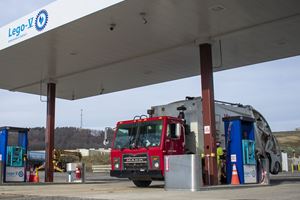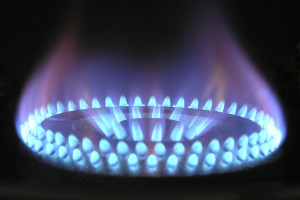Our renewable natural gas displaces carbon emissions equal to taking more than 4,600 cars off of the road, or planting more than 17,000 acres of trees.
Many people think of a landfill as an endpoint. But with Seneca Landfill, it's really just the beginning.
When organic matter is placed in a landfill, it begins to break down over time and generates methane and carbon dioxide gases. Methane and carbon dioxide are greenhouse gases that trap heat in the atmosphere and contribute to global warming. Landfills are therefore required by the EPA to prevent these gases from reaching the atmosphere. Many landfills simply burn off the excess methane and carbon dioxide with a large flare. But Seneca Landfill has chosen to turn the problem into a proactive, environmentally responsible solution.
Follow the journey below as your household waste gets turned into usable natural gas!
Trash Collection
Each week, you put out your garbage in cans, bags or carts. Refuse workers pick up your garbage at the curb in packer trucks and haul it either to a transfer station or directly to the recycling or disposal facility. Transfer stations are permitted facilities intended to consolidate smaller loads of waste and recyclables to facilitate bulk transfer to the ultimate recycling or disposal facility. If you're served by a
Vogel Holding, Inc. hauling company, your trash is disposed at Seneca Landfill and recyclables are taken to TC Recycling.
Transfer stations help keep the cost of disposal affordable and decrease harms associated with truck traffic. To find out more about waste and recyclable drop-off service for businesses and the public, please contact the appropriate company:
Ohio Valley Waste
Tri-County Industries
Valley Waste Service
Seneca Landfill
The Vogel Holding, Inc. hauling companies serve 24 counties in Western PA and Eastern Ohio.
trash collection icon
Deposit into Landfill
The Vogel Holding, Inc. hauling companies bring their collected waste to Seneca Landfill. Solid waste is deposited into a landfill cell. Seneca Landfill is permitted to accept 3,800 tons per day. Each cell is lined and capped to prevent trash migration and water/soil contamination.
landfill icon
Decomposition and Gas Release
When organic matter ends up in a landfill, it breaks down over time. As it breaks down, it generates gases, including methane. Methane is a greenhouse gas capable of contributing to global warming. This gas needs to be diverted from entering the atmosphere.
Landfill gas is typically about 50% methane, 42% carbon dioxide, 7% nitrogen, and 1% oxygen.
gas release icon
Traditionally, landfills have used flares to burn off excess methane and CO2. But in burning off the gas, a valuable resource is wasted. Instead, Seneca Landfill captures methane, converts it into a clean form of natural gas, and uses it as renewable energy. As gas is generated in the sealed landfill cell, it is extracted using wells, blower units and a vacuum system.
2,400 cubic feet of landfill gas are extracted every minute.
Gas Processing Plant - LEGO-V
The landfill gas cannot be used in its raw state. At our on-site methane recovery high-BTU plant, LEGO-V, the gas is converted into a high-quality, usable form of natural gas.
Hydrogen Sulfide (H2S), water, and other contaminants are removed in the pre-treatment stage. Then, the gas goes through the following stages:
- Gas Cooling and Compression
- Pressure Swing Absorption (PSA) Beds
- Carbon Bed Filters
- Membrane Treatment Stage (separates CH4/CO2 molecules)
The refined gas is either used on-site at Seneca Landfill or put into the pipeline, where it will meet its final destination.
refinery icon
Final Destination

CNG Fuel StationNatural gas is compressed at fueling stations. It is used by Vogel's CNG-powered fleet, as well as by members of the public with CNG vehicles.
CNG Icon

PipelineRefined gas is sent by pipeline to the local utility provider for consumer and commercial use. Natural gas may be heating your home or helping cook your food!
Pipeline icon